

The Benefits of Composable Infrastructure for VMware Cloud Foundation on vSAN Ready Nodes
Thu, 25 Aug 2022 17:14:52 -0000
|Read Time: 0 minutes
Discussions comparing the public cloud to on-premise architectures have shifted to discussions about the best way to build a hybrid model.
Multi-cloud delivery services alongside on-premise infrastructure seems to provide the versatility that organizations need for business critical missions, however they are often complex and costly. Ending up with multiple administrative teams, toolkits, and processes doesn’t appeal to most organizations as a winning horse.
As usual, simplicity comes to our rescue. An integrated offering that provides customers with the advantages of both the public cloud and an on-premise infrastructure helps organizations with the following:
- Control infrastructure price and performance
- Improve their deployment times and thus time to value
- Minimize cost and complexity, through a single set of skills and tools
Most organizations that are interested in these benefits are not prepared to build a hybrid cloud themselves. Running an on-premise datacenter or building assets in the main public cloud tends to be more familiar for most IT teams, but managing both at the same time may be beyond the capabilities of some existing IT teams.
In these cases, a trusted partner that brings guidance and innovation to follow this path is crucial. Such a partner can provide a set of familiar management tools with all the administrative and analytics capabilities required to monitor business workloads—such as tools that can be extended to multiple public cloud providers, giving organizations the advantages of compelling cost, efficiency, and speed.
Because most organizations today are using virtualized on-premise infrastructure, VMware comes to my mind as a perfect partner for this journey, having a mature technology offering to help companies build a hybrid cloud.
VMware on Dell offers infrastructure to build a foundational hybrid cloud. This architecture makes the on-premise more cloudy and enables workload mobility to place every workload, whether it is in a public cloud or in our on-premise infrastructure.
Dell PowerEdge MX offers a software defined data center that empowers organizations towards a hybrid cloud model. For example, when this infrastructure is coupled with VMware Cloud Foundation (VCF) and VMware on AWS organizations can build a hybrid cloud using popular VMware tools and capabilities.
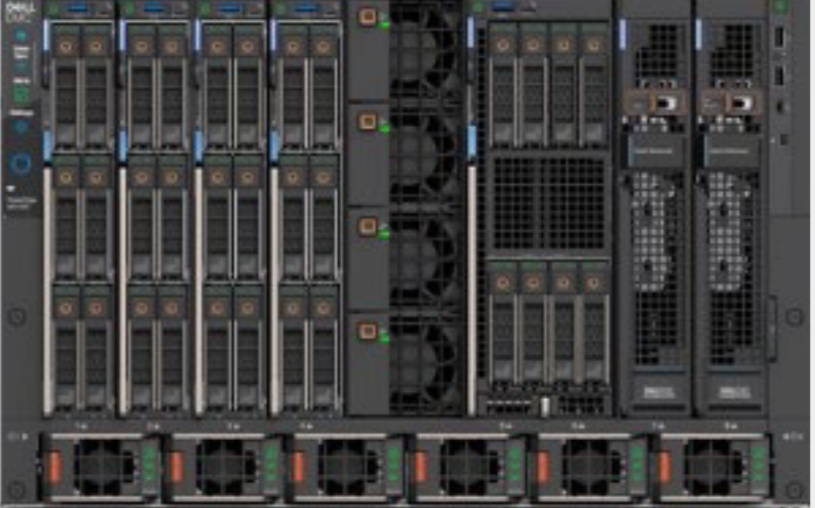
Figure 1: MX composable infrastructure chassis
MX chassis is built with capabilities that perfectly match vSAN requirements. Each node can hold six drives, which ensures that that two of the drives are caching devices within the vSAN cluster for optimal performance.
A low latency smart fabric is built into the MX design. This minimizes the risk that lack of throughput or excessive latency presents for a hybrid cloud deployment. Expandable and extensible by design, the MX family can deliver cloud value across many technology generations.
Dell MX management is integrated with VMware Cloud Foundation 4.x. The MX hardware has the systems’ management and APIs to hook into the VMware consoles that customers are used to. This way we can deploy VCF into the MX infrastructure though a simplified path that eliminates tedious stepwise processes around setup, monitoring, provisioning, and management.
Dell and VMware have also worked together to improve telemetry and insight, giving operators an improved view of resource utilization for each node and chassis in the MX infrastructure.
In summary, the advantages of running VCF on Dell vSAN Ready Nodes based on PowerEdge MX servers include:
- A scalable network design that provides a low latency, automated and not oversubscribed fabric to support any workload deployment the business may need
- A secured stack all the way from the hardware to the VMware management console
- An integrated management with tool set that helps IT admins provision, monitor, and maintain their MX based vSAN Ready Node farm. One console can manage multiple chassis and even other server and storage types.
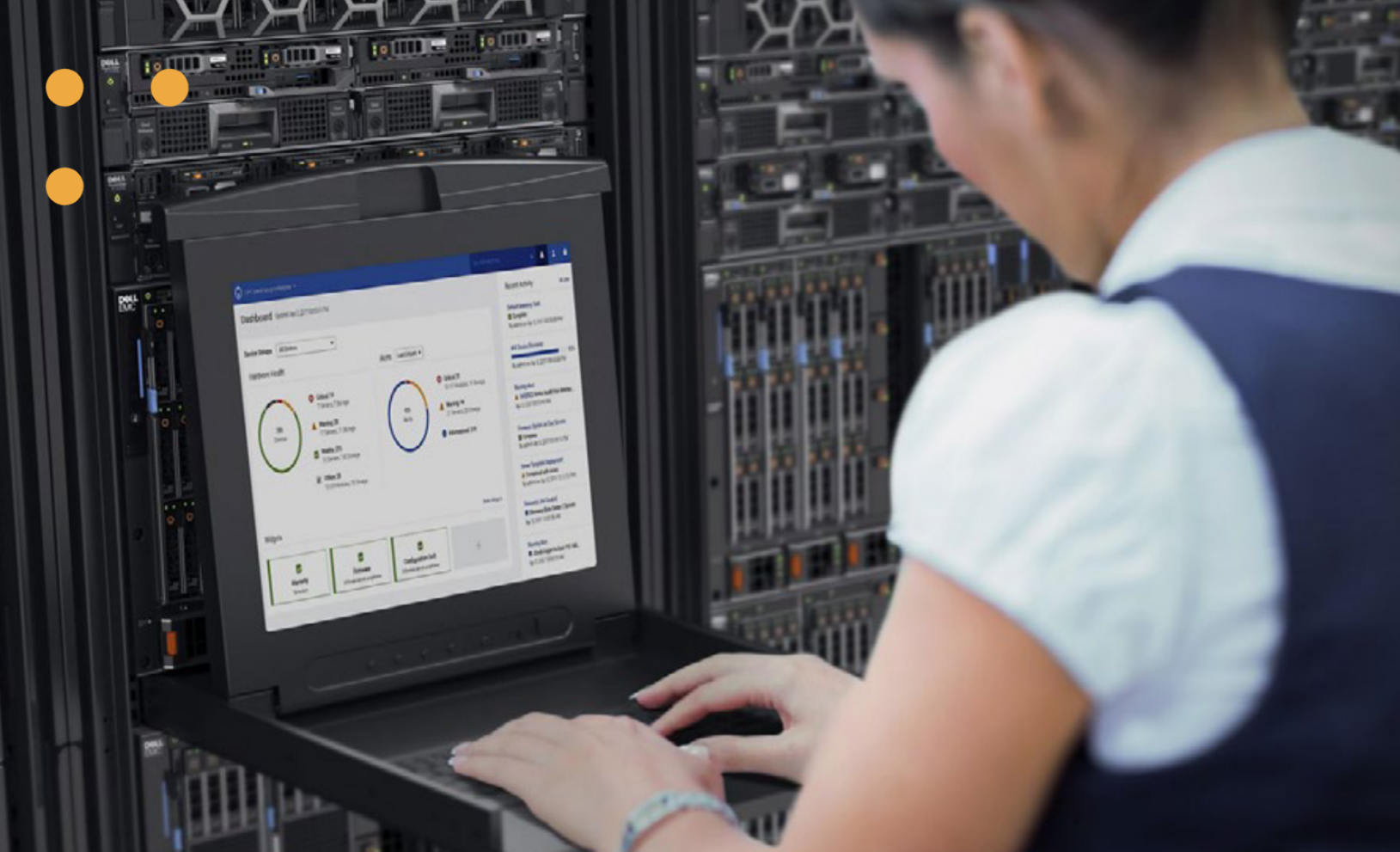
Figure 2: MX integrated management simplifies hybrid cloud operations
One way to see the integration of VCF with MX based vSAN Ready Nodes in action is to deploy a new workload cluster of Dell vSAN Ready Nodes MX750c into an existing VCF infrastructure.
Principled Technologies performed this test and showed how simple and straightforward the expansion process is with MX servers. They also showed, by following the same expansion process with two generations of MX servers (MX740c and 750c), that the tools and processes remain the same across server generations.
The engineers completed the expansion process in just two hours and 21 minutes. It took the same time for each of the two server generations.
For more information about this test case, see the Principled Technologies report.
Conclusion
Although building a functioning hybrid cloud to support real business workloads may look complex, it can be simplified if by using the proper technologies and tools. VCF combined with Dell vSAN Ready Nodes MX composable infrastructure offers a perfect duo to reach an organization’s hybrid cloud goals.
You can read more about Dell vSAN Ready Nodes at the Dell Technologies Info Hub.
Author information
Iñigo Olcoz
Twitter: @virtualOlcoz
References
Related Blog Posts

Simplifying Security Operations for Dell HCI Platforms with NSX
Thu, 08 Sep 2022 16:58:04 -0000
|Read Time: 0 minutes
Today, most technology companies in the IT space work to offer customers not only the best technology innovations but also those that help simplify their day-to-day lives.
One example of this is the new vCenter plug-in for NSX-T, introduced with vSphere 7.0 Update 3c and NSX-T 3.2. Through this new deployment method for NSX-T, management and operations users can now use NSX-T as a plug-in for vCenter, similar to how earlier versions of NSX were configured. Through wizard-assisted operations, security policies can easily be configured, deployed, and operated within vCenter.
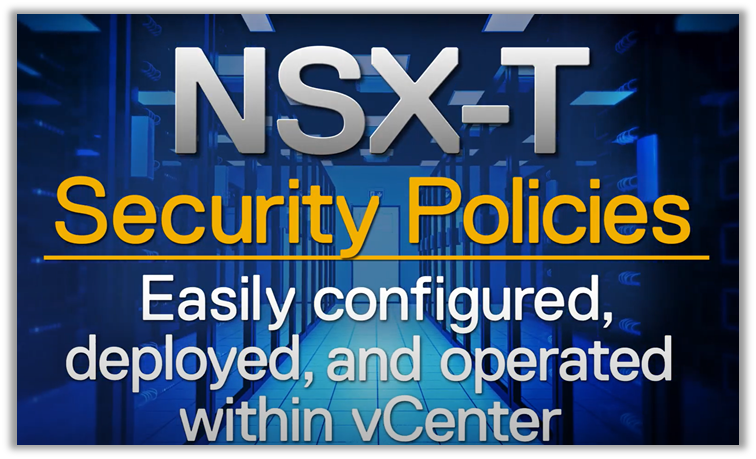
Figure 1. The new vCenter plug-in for NSX-T simplifies security deployment and operations
For Dell HCI platforms such as VxRail, vSAN Ready Nodes, and PowerEdge servers hosting vSAN-based workloads, NSX becomes an optimal network and security engine.
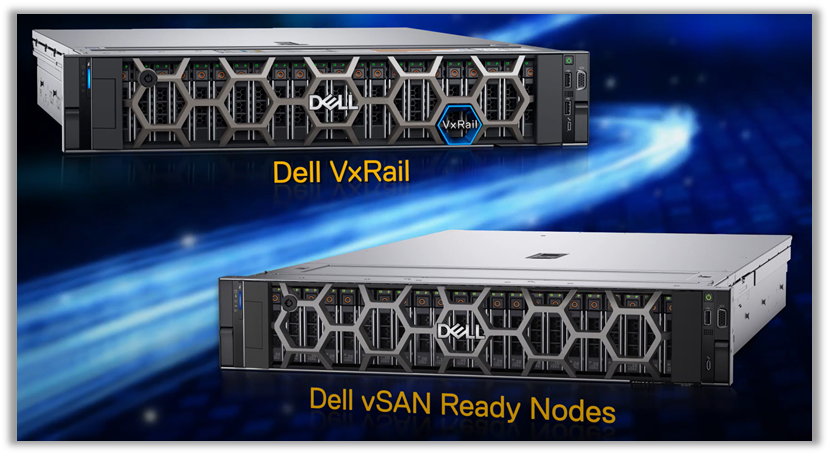
Figure 2. Dell HCI platforms such as VxRail or vSAN Ready Nodes become the perfect targets for the new vCenter plug-in
The whole process is simple. It can be completed by following these steps:
- Install NSX-T Manager and provide a license key.
- Install the new method to configure and operate NSX security, the vCenter plugin for NSX.
- Configure the distributed firewall policies for the HCI cluster:
a. Define infrastructure services as needed (DNS, DHCP, custom…).
b. Create the environment to consume the defined infrastructure services. - Define how the elements in the environment can communicate with each other.
- Define communication strategies for applications in the environment.
- Review and verify the defined security policies before they are published and effective.
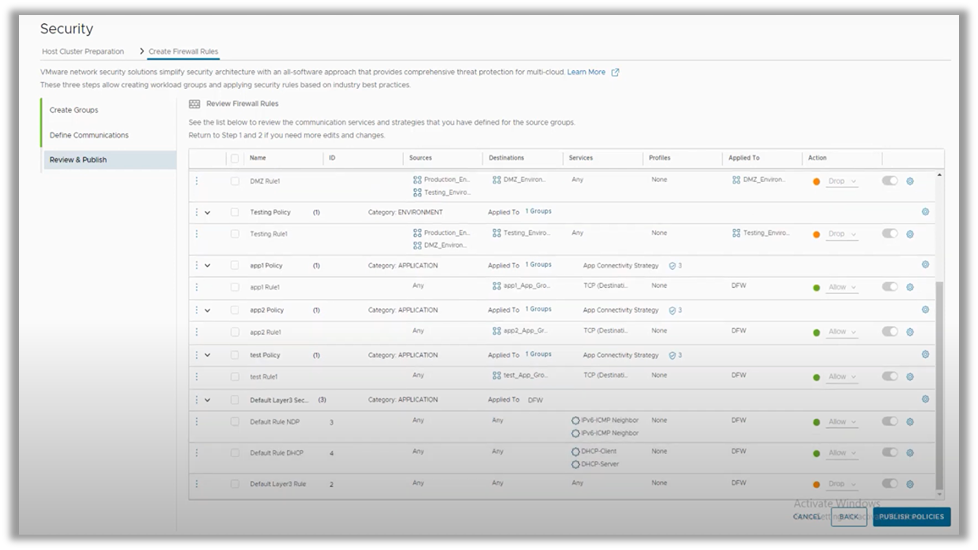
Figure 3. Defined NSX security rules can be reviewed before going live
If you want to learn more about how simple security operations can become with the new vCenter plug-in for NSX, take a look at this video.
Author: Inigo Olcoz
Twitter: VirtualOlcoz
References
- VxRail Info Hub
- vSAN Ready Nodes Info Hub
- HCI Security Simplified: Protecting Dell VxRail with VMware NSX Security
- Simplifying Security Deployment and Operations for Dell HCI Platforms
- Video: Simplifying HCI Security with the New vCenter Plug-in for NSX

Form Factor Fun with Dell EMC vSAN Ready Nodes
Mon, 20 Dec 2021 13:00:54 -0000
|Read Time: 0 minutes
Form Factor Fun with Dell EMC vSAN Ready Nodes
When thinking of a VMware vSAN-based integrated solution, it is clear that the virtualization layer is a key technology piece. That virtualization layer abstracts the classical hardware domains, compute, storage, and network, to present users with a consolidated view of their data center hardware resources through the vSphere abstractions.
Even still, the underlying hardware plays a main role. It is responsible for the specific characteristics of its processors, memory, IO devices, and storage, and also for the available form factors in which that set of hardware resources can be installed and deployed.
Having a rack mount, tower, modular, and ruggedized servers to deploy a vSAN Ready Node environment offers robust choices to adapt infrastructure to customer business needs.

VMware with vSAN can host almost any existing workload today. This ability gets a boost when the underlying platform is also capable of showing different forms, sizes, and infrastructure offerings, such as those in the Dell EMC PowerEdge portfolio.
Some of the most common data center choices are the types of servers that can be installed within a rack: rackmount and blade servers. These server types achieve optimal space and power utilization when compute density is a desired goal—a key design criteria for many facilities.
The range of rack mount and composable infrastructure available in the Dell EMC vSAN Ready Node family is extensive, at 14 different server types. This wide range of options allows customer to find the perfect resource fit for their specific workload demands. It’s likely that the compute, storage, and network mix they are looking for can be found in the exact requested proportions among the 14 server platforms.
This range of options also enables an important price flexibility, as customers can choose the most affordable options to suit their needs.
Even platform homogeneity represents an operational savings opportunity. Many companies have gone through infrastructure standardization campaigns to explore the benefits of sizing, designing, operating, servicing, and lifecycle managing the most homogeneous server platform possible. The broader the server offering is, the greater the chance that the bare metal deployments need alignment with the VMware-based infrastructure.
The rack mount format offers servers ranging from 1 to 2U, and from one to four sockets. Rack servers can include up to 112 Intel Xeon Scalable processors, 6 TB of RAM, and 24 direct-attach NVMe drives, and in the PowerEdge R840 in just 2Us.

The full rack mount and composable portfolio looks like this:
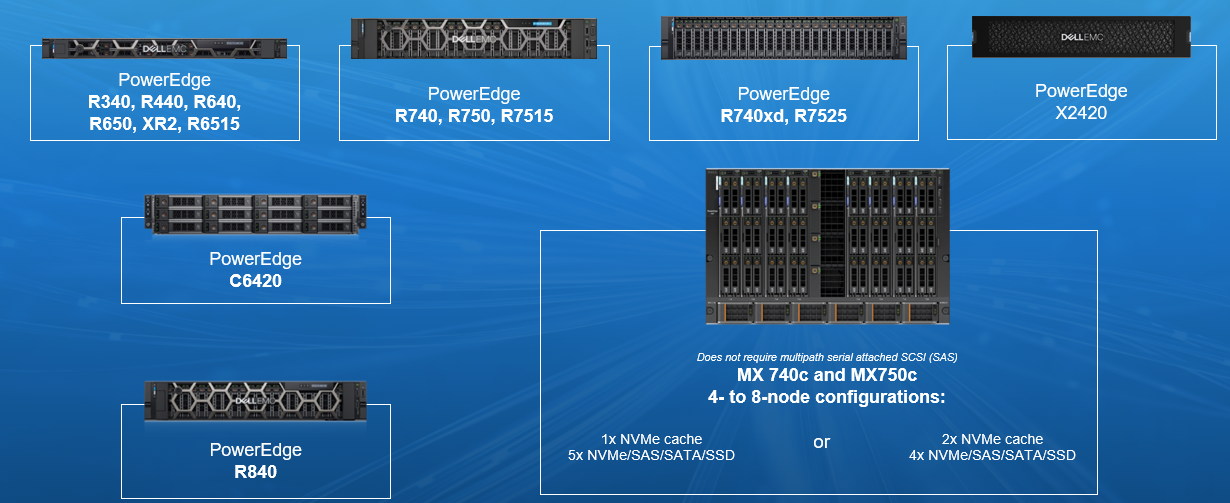
With 5G and edge becoming mainstream, they have enabled new business opportunities from next-generation applications and services. There is an increasing need for businesses to have IT resources as close as possible to the data creation place.
But the edge is a place with some inherent constraints in space, power, and cooling, coupled with limited bandwidth and limited IT staff. There are two great choices for this challenging space among the Dell EMC vSAN Ready Node portfolio:
- Dell EMC XR2 vSAN Ready Node: Built for rugged environments, this option is able to operate in temperatures up to 45⁰C and avoid thermal damage up to 55⁰C with high shock, vibration, dust, humidity, and electromagnetic interference (EMI). With a minimal footprint of 1U and short depth, this option is ideal for space-constrained installations.

- Dell EMC T340 and T350 vSAN Ready Nodes: With the T350 vSAN Ready Node coming soon, these reliable platforms in a tower form factor represent a great choice for edge locations because they allow customers to build a scalable IT platform by starting small, with an affordable investment. To address the demands and typical constraints of edge locations, including space constraints, communications constraints, and minimal staff at edge locations, the T340 and T350 provide a cyber-resilient architecture that includes reduced server size, thermal efficiency technologies, and advanced security features.
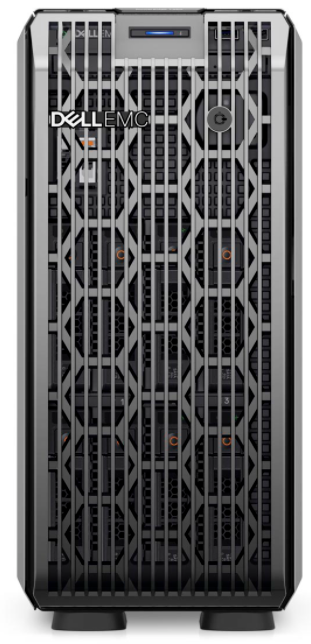
Finally, the PowerEdge MX kinetic infrastructure is a rack-based modular chassis uniquely designed to support new processor technologies, storage types, and fabric advances. These capabilities provide the foundation for software-defined environments.
PowerEdge MX7000 hosts elastic compute and storage resources connected by a Smart I/O fabric in a flexible 7U modular enclosure, able to hold two and four sockets in its compute sleds.
The Dell EMC MX750c vSAN Ready Node is one of the latest additions to the MX ecosystem, supporting up to two 3rd Generation Intel Xeon Scalable Processors (Ice Lake), 32x DIMMs, and PCIe Gen4, which enables faster NVMe drives and NICs.
The MX750c adds a flexible building block to the Dell EMC vSAN Ready Node family that helps to reduce deployment risks with certified configurations and to improve storage efficiencies that can help when building the vSAN clusters.
Dell EMC MX750c vSAN Ready Nodes offer the platform flexibility that allows customers to add resources as business peaks demand.
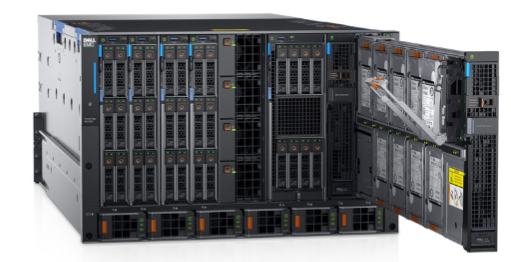
In conclusion, having a wide range of available form factors is a crucial aspect for any infrastructure offering, allowing customers to choose the best platform for each business case.
Dell EMC vSAN Ready Nodes delivers some of the best of breed rack mount, blade, and tower server options to deploy a vSAN cluster. For more information, see the vSAN Ready Nodes InfoHub site.
Author: Iñigo Olcoz, Senior Principal Engineering Technologist at Dell Technologies
Twitter: @VirtualOlcoz


